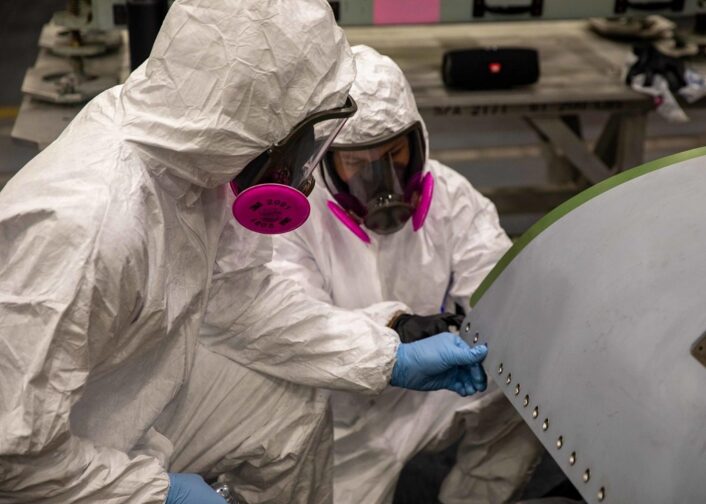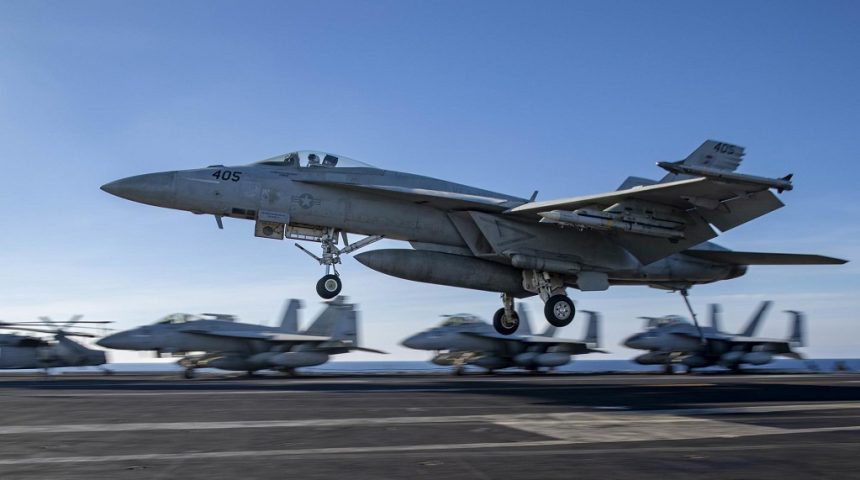The F/A-18E Super Hornet was heavily damaged after an in-flight engine fire at the beginning of the USS Bush deployment last summer.
A heavily damaged F/A-18E Super Hornet has been repaired at sea and returned to flight status in what the U.S. Navy defined as first-of-its-kind repairs. The aircraft, attached to Strike Fighter Squadron (VFA) 136, suffered an in-flight starboard engine fire on Aug. 31, 2022, during routine flight operations immediately after the beginning of its operational cruise aboard the USS George H.W. Bush.
According to the press release, the degree of fire and heat damage to the 68R door skin, vent screen, formers, S11 skin, starboard engine bay, and all accompanying hardware would normally result in the aircraft being inoperable for the remainder of deployment, and craned off the ship and transported to a location capable of handling the repairs upon return to homeport.
After the in-flight emergency, the pilot relied on the Super Hornet’s second engine to perform a safe emergency landing on the aircraft carrier. Following the successful recovery, maintainers evaluated the aircraft and found there were noticeable charring and burns on multiple components. Since the aircraft would have had to stay in the hangar bay waiting repairs until it could be craned off, maintainers investigated about the possibility to perform the repairs at sea.
“The fire damage identified was extensive enough to require an engineering investigation to determine the feasibility for a repair at-sea, but we were committed to getting the aircraft back into the sky as soon as possible,” said Lt. Cmdr. Russell Huff, maintenance officer of CVW-7. “Since this was the first-ever at-sea replacement of a 68R Door and S-11 Skin, considerable time was required to plan and approve the repair. Once the engineers had believed this repair could be accomplished at-sea, or at least that a repair could be attempted, things went very smoothly.”
After many emails and phone calls, Fleet Readiness Center Southwest (FRCSW) and other commands at Naval Air Station (NAS) Oceana, NAS Sigonella, and Naval Station Norfolk prepared the technical experts, tools, and parts for delivery to George H.W. Bush on deployment. This preparation work took more than three months, but the result was the improved tactical air capacity of the deployed strike group and a pathway for future cooperation in similar situations, says the Navy.

“Coordinating logistics efforts across multiple bases, FRCs, and supply ships was a challenge worth undertaking to prove we could maintain full capabilities at sea,” said Cmdr. Donald McIntyre, supply officer for George H.W. Bush. “Coordinating tools and parts for repairs and maintenance is regular business for the supply department, but helping VFA-136 push the boundaries of what experts thought was possible was our unique pleasure.”
The press release reports it took 33 days to perform these first-of-their-kind repairs at sea after the craftsmen from FRCSW and parts arrived aboard, completing the works on January 9, 2023. Due to the effort of all parties involved, the repairs were completed while deployed, demonstrating the capacity of deployed aircraft carriers to effectively manage and employ a full range of warfare capabilities by cutting down repair times and preserving the operational readiness and mission capabilities of Carrier Strike Group (CSG) 10 and Carrier Air Wing (CVW) 7.
“The expert repairs of the FRC artisans proves it’s possible to perform this crucial maintenance in a deployed environment, making us a more lethal fighting force and providing a springboard to return even greater repair capability back out to sea.” said Capt. Thomas Bodine, commander, CVW-7. “Asset readiness and operational readiness are inseparable. Our ability to maintain and repair our aircraft while underway is a critical warfighting competency. The resounding success of this significant at-sea repair, along with those that will surely follow, will enable the Navy’s Carrier Air Wing force to deliver decisive combat victories, today, tomorrow, and for many years to come.”
The George H.W. Bush CSG is currently on a scheduled deployment in the U.S. Naval Forces Europe area of operations, employed by U.S. Sixth Fleet. The USS George H.W. Bush is the flagship of CSG-10, which also includes the Arleigh Burke-class guided-missile destroyers USS Nitze (DDG 94), USS Farragut (DDG 99), USS Truxtun (DDG 103), and USS Delbert D. Black (DDG 119), and the Ticonderoga-class guided-missile cruiser USS Leyte Gulf (CG 55).
The squadrons of CVW-7 embarked aboard the aircraft carrier are the “Sidewinders” of VFA-86, the “Jolly Rogers” of VFA-103, the “Knighthawks” of VFA-136, the “Pukin Dogs” of VFA-143, the “Bluetails” of Carrier Airborne Early Warning Squadron (VAW) 121, the “Patriots” of Electronic Attack Squadron (VAQ) 140, the “Nightdippers” of Helicopter Sea Combat Squadron (HSC) 5, and the “Grandmasters” of Helicopter Maritime Strike Squadron (HSM) 46.









